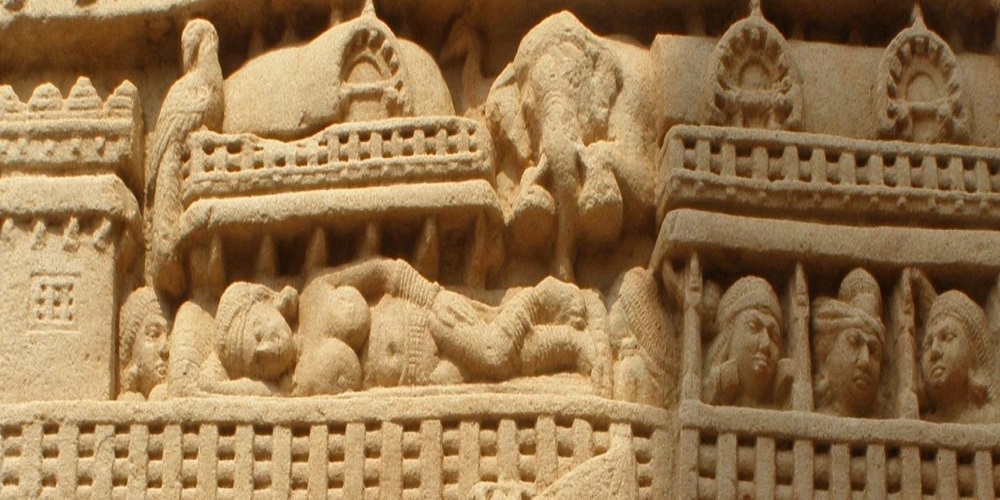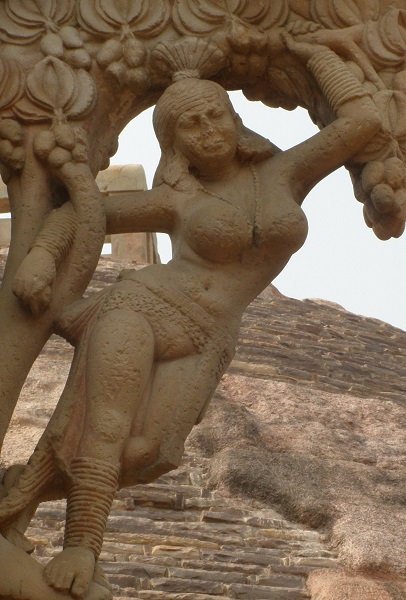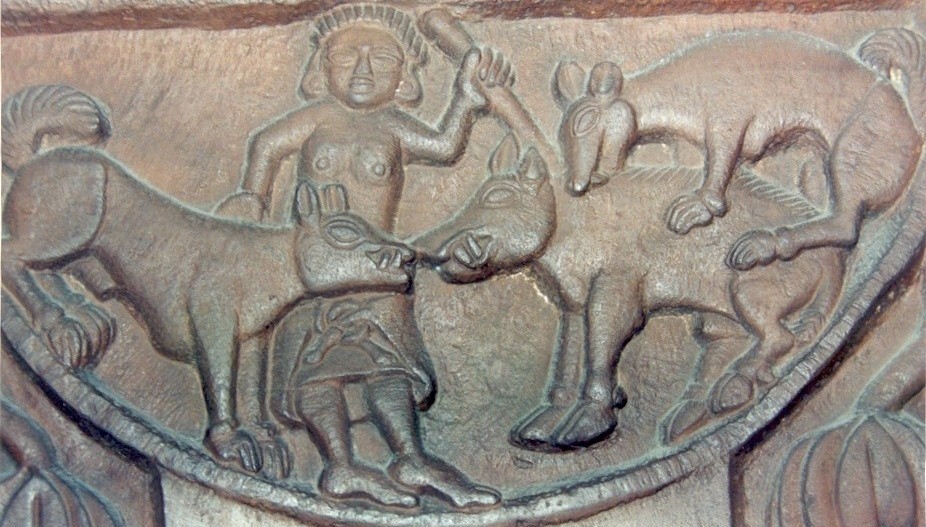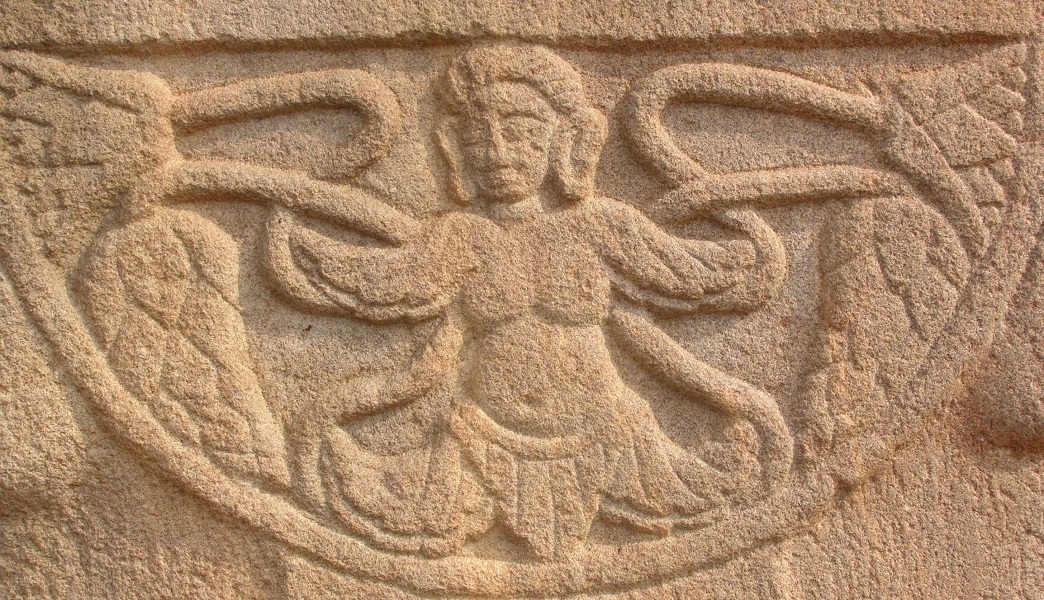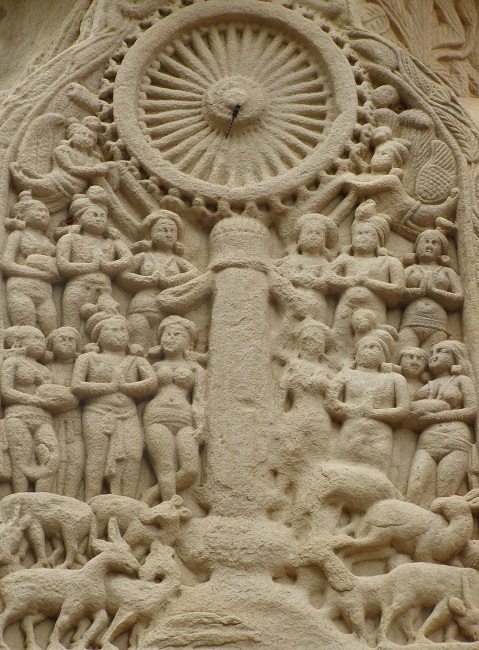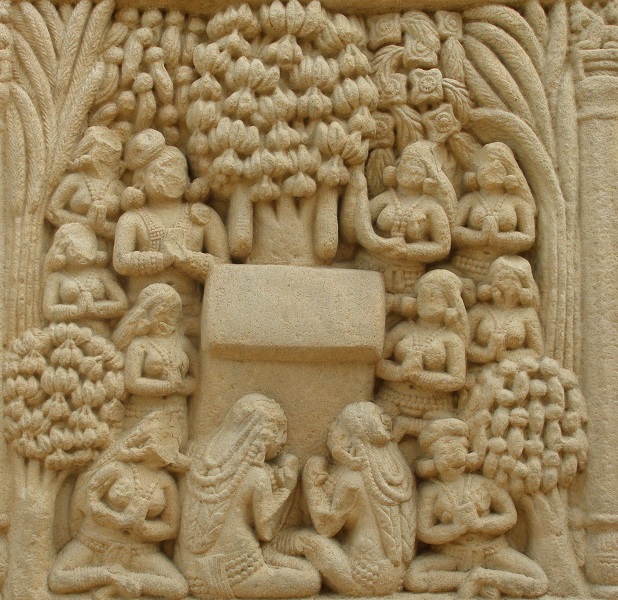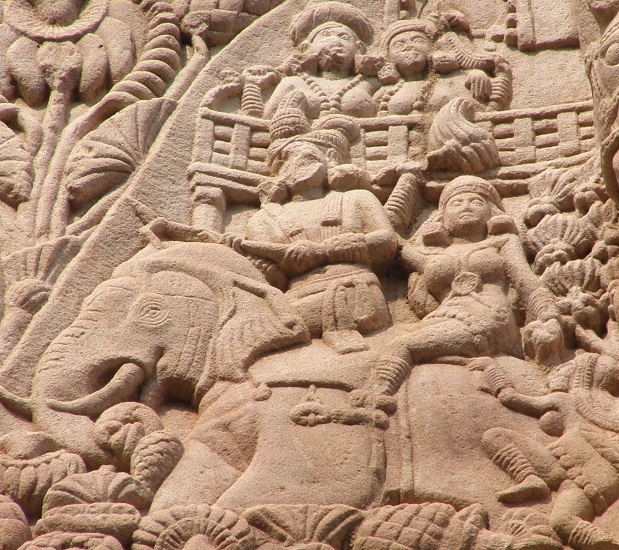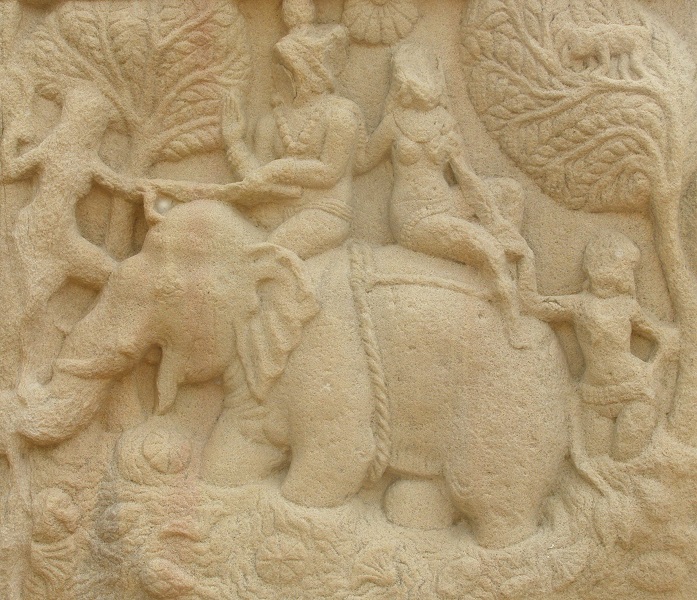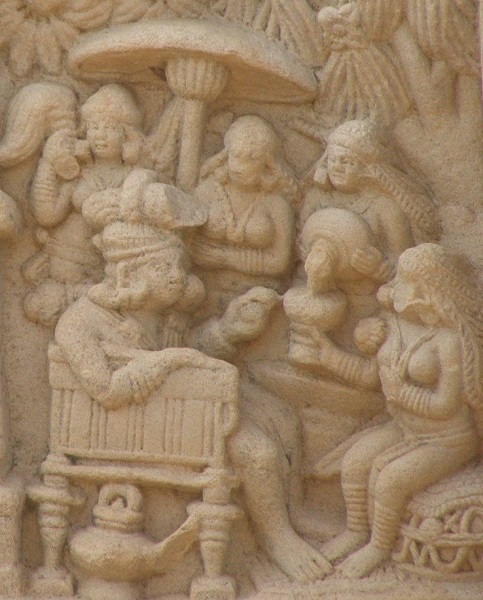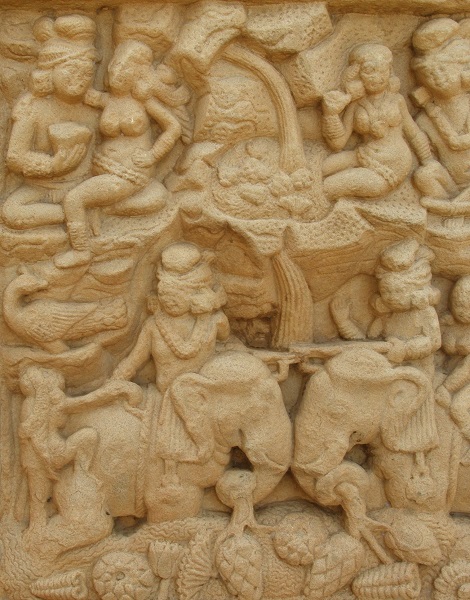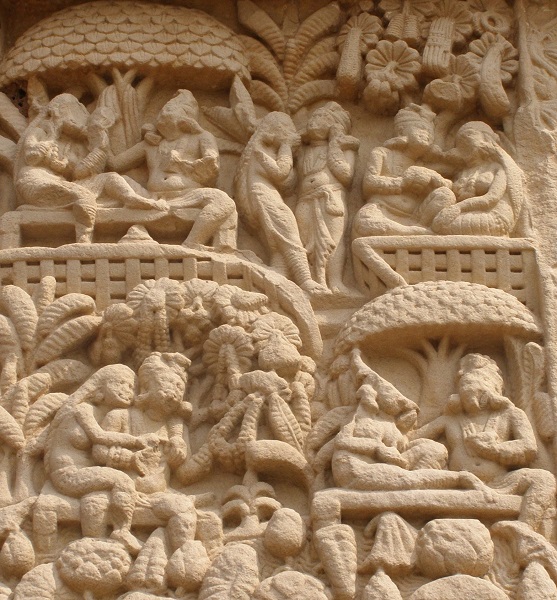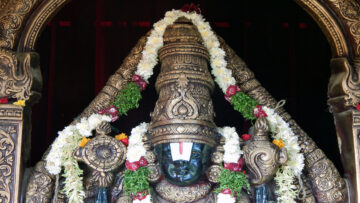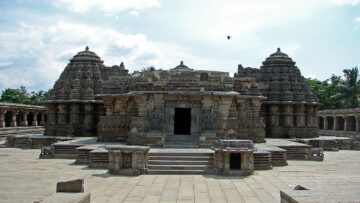Abstract
The main objective of Buddhist philosophy right from its inception was to popularise the teachings of Buddha among its followers and compel the incumbents of saṁgha to live a disciplined life, and so was the objective of Buddhist art. In an attempt to achieve this goal, early Buddhist artists began carving various scenes from life of Buddha, Jatakas and Buddhist motifs with great enthusiasm. The early Buddhist sculptural art gave emphasis on carving life scenes from present and past lives of Buddha but it did not overlook the contemporary life in art as contemporary society was very explicitly carved in Buddhist art in background of Buddhist motifs and episodes. The socio-cultural environment depicted in sculptural art proved very helpful in reconstructing the contemporary society of central India on the basis of materialistic evidence present in sculptural art. As we all know, women are an integral part of any society and a society overlooking her active involvement, liberty and respect cannot survive for long. The early Buddhist sculptural art in central India depicted women performing various religious rituals, carrying out family responsibilities and proving her devotion towards her husband and family. But it doesn’t imply that her individual desires were overshadowed as that too was richly represented in the sculptural art form. Moreover the early Buddhist art in central India that flourished during Śuṅga-Sātavāhana period reflected a multidimensional facet of a woman’s personality as a whole.
The present paper proposes to discuss the multidimensional role of women depicted in early Buddhist art of central part of India like Bharhut, Sāñc̣ī, Sonārī, Satadhārā, Bhojapur, Andher which were situated at point of intersections between the south and north. The paper with the help of plates intends to explore various acts of women in performing her social responsibilities and expressing her feminine desires through sculptural representations in early Buddhist art of central India.
Buddhism and Women
Gross (1993) in her book Buddhism After Patriarchy: A Feminist History, Analysis, and Reconstruction of Buddhism makes a crucially important and extensive study of all the main sects of Buddhism from a cross-cultural, religious and feminist point of view stating her principal objective as “a feminist revalorization of Buddhism”, analyzing the key Buddhist concepts and attitudes that shape its world view. She as well as other scholars are divided about whether there is a case for feminism in Buddhism, especially in Theravāda or early Buddhism seen largely as shaped by patriarchal attitudes as opposed to the later developments in the Mahayāna and Vajirayāna traditions more favourable towards women. As we all know that women have always played a significant role in Buddhism as lay disciples as well as monastics later on influencing the order and societies where Buddhism took root (Dewaraja 1994). The view that early Buddhism displays a strong patriarchal and even misogynistic attitude towards women is based mainly on the recount of the Buddha’s initial refusal to grant the request of his aunt and foster mother, Prajāpati Gautami and her women to become monastics three times. According to the Buddhist text Vinaya Pitak, the Buddha initially refused her request.
Here is the story: Prajāpati Gautami was the sister of the Buddha’s mother, Maya, who had died a few days after his birth. Maya and Pajapati were both married to his father, King Suddhodana, and after Maya’s death Pajapati nursed and raised her sister’s son. After his enlightenment, Prajāpati Gautami approached her stepson and asked to be received into the sangha. The Buddha said no. Still determined, Pajapati and 500 women followers cut off their hair, dressed in patched monk’s robes, and set out on foot to follow the travelling Buddha. When Prajāpati Gautami and her followers caught up to the Buddha, they were exhausted. Ananda, the Buddha’s cousin and most devoted attendant, found Pajapati in tears, dirty, her feet swollen. “Lady, why are you crying like this?” he asked. She replied to Ananda that she wished to enter the Sangha and receive ordination, but the Buddha had refused her. Ananda promised to speak to the Buddha on her behalf. Ananda sat at the Buddha’s side and argued on behalf of the ordination of women. The Buddha continued to refuse the request. Finally, Ananda asked if there was any reason women could not realize enlightenment and enter Nirvana as well as men. The Buddha admitted there was no reason a woman could not be enlightened. “Women, Ananda, having gone forth are able to realize the fruit of stream-attainment or the fruit of once-returning or the fruit of non-returning or arahantship,” he said.
The Pāli Canon mentions that it was Venerable Ananda who finally convinced the Buddha through presenting a logical case on behalf of the women as the Buddha himself admitted that they were fully capable of attaining the highest goals on the oath to enlightenment or nirvana. Also, the Buddha is also said to have declared that his original prediction of the teachings lasting for 1000 years would be halved if women were allowed to ordain. In addition, it is also said that he introduced extra 85 rules for the bhikkhunis (nuns) including eight special rules ensuring that they would always be subordinate to the monks (Buddhanet 2008): The special rules for nuns were:
(1) In matters of respect and deference, a monk always had precedence over a nun,
(2) A nun must spend the rains retreat in a place separated from monks,
(3) Nuns must ask monks for the date to hold the Uposatha and about teaching the Dharma,
(4) When a nun did wrong she must confess it before the community of both nuns and monks,
(5) A nun who broke an important rule must undergo punishment before both the nuns and the monks,
(6) A nun must be ordained by both an assembly of nuns and of monks,
(7) Nuns must not abuse or revile a monk, and
(8) A nun must not teach a monk.
These eight garudhammas are often cited as evidence of Buddha’s wish to denigrate women and preserve male dominance even within the Order. A practical explanation for Buddha’s initial reluctance in accepting women into the Order is that maintaining celibacy, which is crucial to the monastic way of life, would become very difficult with the admission of women resulting in the Order lasting for a lesser period. After joining Sangha, women found dignity and respect like Sumangala, Mathika, Vasanti, Sumedha, Utpalavarna. Several sex workers who were looked down upon by society joined the sangha and acquired a respectable place. Arthakasi of Kasi, Padmavati of Ujjain and Ambapali (Amrapali) of Vesali were noted women who came from this background and enjoyed a high reputation.
Woman in Sculptural Art of Central India
Woman is an important and integral part of society. A society could not persist and flourish without giving suitable respect and liberty to a woman. In wake up of illustrating the contemporary life in background of Buddhist narratives, the active involvement of women is very vibrantly reflected in art. In accordance with change of time the society indebted with new social trends reflected this in art too. The social norms and values which are adopted by the society are accordingly transformed into art, including the attitude of society towards women. The study of early Buddhist sculptural art and presence of women into various religious and secular narratives helps us to trace position of women in early Buddhist art.
The Buddhist legends suggest that Buddha as an infant entered the womb of Mahāmāyā, the queen of king Śuddhodhana in form of a white elephant. The incidence was an outcome of a collective request pleads by devatās in Tuṣitā heaven. It is affirmed by many Buddhist sources that after conceiving the child the queen requested her husband to permit her to go to her parental house and in the midst of the way to Devadaha at Luṁbinī, she developed a desire to play with Śāla tree where she delivered the Siddhārtha who became famous as Gotama Buddha in future. The sculptor in Buddhist sculptural art beautifully attempted twice to establish interconnection between the human being and nature. First in course of depicting the white elephant entering the womb of the queen during a night of āṣādha utsava and secondly during Gotama’s birth in auspicious Śālavana of Lumbinī. The above two incidents from the life of Buddha encouraged sculptors to carve such scenes in good number where queen Māyā is shown in pre and post natal activities in Śālavana of Lumbinī.
An illustration having an inscription engraved on top of the carving states ‘Bhagavato Utkrānti’ which means descent of lord (Mitra, 1980: 1). It gives an impressive and elaborative illustration of dream of queen Mayā. The scene shows Māyā sleeping calmly on a cushioned bed resting her right hand under head. Turning to her right side she is depicted with bare chest with manifesting hair dressing in form of a big hair bunch. She is dressed with number of ornaments in ear, neck, wrist and arms. The multi stringed maṇi- mekhalā (girdle) and hāra worn by her affirms her royal identity. The elephant on the top dominate the entire composition and the size of the elephant is very much conditioned with its utter importance. The bodhisattva in form of a giant elephant is carved appearing from above in the sky to enter the womb of Māyā. The two tusked elephant is depicted with an elegant head dress comprise of a decorative cloth added with a frill of pearls fixed to the edge of cloth. The illustration is further carved with the presence of three women attendants. The first one standing at the back side of queen is carved praying the holiness while the other two are shown seated on separate pitḥikās. The first one is carved moving a c̣āmara over queen perhaps to move flies away and the second one is appeared dozing due to her hectic and busy schedule in royal harem. The room is provided with a night lamp and a bhringāra for the convenience of queen (Plate 1).
(Plate 1: Dream of Maya, Bharhut, Indian Museum, Kolkata)
Aesthetically speaking the different items in the story are shown in isolation with each other; they seem to exist by themselves since no linear rhythm binds them into one uniformity (Ray, 1975: 111). The same narrative is carved at the northern pillar of eastern toraṇa at Sānc̣ī-I. Carved inside a square panel Māyā is shown here sleeping inside Siri-Gabba of a tribhūmika prāsāda to her right side. The illustration of dream episode at Sānc̣ī is different in many respects to its predecessor at Bharhut. In contrast to Bharhut her bed is placed in an open ālinda to enjoy unhindered air flow. The absence of night lamp and snoozing attendants gives it a less mystic look and makes difficult to associate with an event happened during night. The illustration shows a bust of a women attendant in very cautious gesture and humble towards sleeping Māyā. The bodhisattva as an elephant is depicted from front side coming down from the sky. The roof of the ālinda is occupied by two peacocks at both divergent edges (Plate 2). Instead of the sculptural presentation at a panel of interior pillar the depiction is not well organised and conceptualized in comparison to Bharhut where the artist has performed his classiness to live an environment of night and witnessing a dream in bedroom of queen Māyā with abundance of royal elements.
(Plate 2: Maya dream & visit to Kapilavastu, Eastern Gate, Rear Face, North Pillar, Sanchi)
The earlier Buddhist sculptural art of central India is well acquainted with the presence of divine element having great association with Vedic elements. The ancient literature considers ‘Śree’ as a symbol of eternal beauty and virtue and a source of prosperity. In Buddhist sculptural art the sculptor attempted to conceptualize ‘Śree’ and ‘Laḳśmī’ together as goddess of all of the creations (Trivedi, 1991:78). In this regard considering the popularity of the motif the sculptor has presented Laḳśmī in various forms. She is presented at the entrance as toraṇa-Laḳśmī or dvāra-Laḳśmī; sitting on a throne as padma-Laḳśmī symbolising various directions and carrying a c̣āmara, cḥatra and as gajalaḳśmī being anointed by elephants. The back side of second architrave of northern gateway carves Māyā sitting in a peculiar position. Here two elephants are shown pouring water over her indicating about giving holy bath to invisible child symbolically presented by cḥatra. The scene shows elephants performing rituals and praying for the upcoming child. The elephants are carved standing on lotuses and had carried a kalaśa in trunks. Queen Māyā is sited on a lotus in ardha-līlāsana folding her right leg over. She has placed her left leg over another lotus emerged out from water. The coming out of several aquatic vegetations and extended belly affirms her being carrying a child in her womb (Plate 3). On the western pillar of the backside of stūpa-III at Sāñc̣ī, Māyā is again depicted in almost same manner with few variations. In contrast to the previous depiction the trunks of the elephants are intersecting each other diagonally and the queen has carried a semi blossomed lotus which perhaps affirms the symbolic presence of child who is yet to be delivered.
(Plate 3: Gajalaḳśmī, Northern Gate, Rear Face, first Architrave, Sanchi)
The motif of Śālabhañjikā is taken as also of vṛiḳśikā in early Buddhist art where a woman is carved playing with branches of tree other than Śāla. The eastern gateway of Sāñc̣ī carves a beautiful vṛiḳśikā grabbing a bough of a mango tree. In such an attempt her breasts are emerged out like an elaborated swarṇghaṭa. Her locks spread out over her back and are brought up on the crown of her head into a curious top-knot (Rao, 1994:60). The bodily features of this vṛiḳśikā are clearly visible under the transparent cloths worn by her. Though the sculpture is less ornamented and simple in nature still it could be placed in category of some of the magnificent sculptures from Sāñc̣ī. The Śālabhañjikā enjoined with the western pillar of northern gateway is fragmented and appears like swinging from the bough of tree. Her eyes reflect to be looking downwards likewise willing to oblige the people visiting her. She has grabbed a mango in her right hand and snatched the fame of her antariya from the other which is tied to her waist from behind. Her dense hairs are dressed into many plaits over her back and give her a splendid appearance (Plate 4). Just below the uppermost architrave of the northern gateway a small size of Śālabhañjikā is carved. Depicted in quite fabulous way she has clanged the trunk of tree from her right leg. These Śālabhañjikās of comparative small size are normally downward looking but are carved with extra elegance. They draw the attention of spectator in same way like the other Śālabhañjikās carved in big size. In addition to the stūpas of Sāñc̣ī the site museum exhibits some beautiful presentations of Śālabhañjikās. A sculpture shows her standing under a mango tree. She has worn two long hāras in neck which shows the pendants clinging between the breasts. She is dressed with similar dressings, coiffure and ornaments like her counterparts on the stūpas. The standing posture of this Śālabhañjikā especially her upper portion from the waist is very impressive. Her body is carved with a deep inclination towards left side. She has grabbed the branch of the mango tree very tightly and is dressed with precious ornaments and dressing. The sculpture has great resemblance with the Śālabhañjikā carved on eastern gate of stūpa but is certainly not facilitated with such minute details and plasticity.
(Plate 4: Śālabhañajikā, Eastern Gate, Front Face, Sanchi)
The archaeological evidences of Yaḳśa clan can be easily traced back to Mauryan times when the art was patronized by state. The presence of Parkham yaḳśa and Maṇibhadra yaḳśa from Pawaya generally famous as Patna yaḳśas indicate the earliest artistic inception of this theme into sculptural art though in cruder form. But the lack of maturity and perfection reflected in Patna yaḳśas was soon overruled by Didāraganj yaḳśiṇī which is fully proportionate and skilfully completed from all sides (Tomory, 2000:168). It was Śuṅga period when first time large number of yaḳśiṇī images are carved freely. The sculptor has no compulsion to go with the paradigms established by state and has all sort of liberty to carve the motif in accordance to his desires, conceptualization and experimentation. It is significant to notice that most of the yaḳśiṇī images carved during the Śuṅga period are carved with some vāhana under them but just on the basis of this observation we cannot associate a particular vāhana with a particular yaḳśiṇī. It is evident to notice that although the number of yaḳśiṇī images belong to Śuṅga period is large yet almost all of the images have some peculiarity and distinction. The images of yaḳśiṇīs have a wide range from the well ornamented busts to a spectator observing and commanding animal fights (Plate 5). The yaḳśī reliefs carved in the Śuṅga period gives a good glimpse of semi-divine elements inherited with them. A yaḳśīṇī from Sāñc̣ī is carved at stūpa-III in annoyed mood. She has wings added to her hands and creepers are emerging out from her body (Plate 6). The image gives mixed impressions of various elements like divinity, capability and fertility inhabited in her.
(Plate 5: Woman watching animal fight, Bharhut, Indian Museum, Kolkata)
The gratitude, devotion and admiration of women to Buddha and dhaṁṁa is very exclusively illustrated in early Buddhist art. We can easily trace her engaged in preparing herself to visit and worship Buddha. The early Buddhist sculptural art has number of depictions where a woman is shown worshiping Buddha in symbolic form. The sculptural art gives a good glimpse of various rituals, protocol and etiquette followed by people while visiting Buddha or other deities accepted in Buddhism. It could be easily traced in sculptural art that how under changed circumstances she joined religious performances alone and with other female colleagues. Similarly she is shown with equal courage and elegance by joining her male counterpart while visiting various religious assemblages and discourses.
(Plate 6: Yaksini, Sanchi Stūpa II)
The western pillar of eastern toraṇa at Sanchi gives a colourful depiction of the first sermon of Buddha given at Mrigdāva near Kāśī after the enlightenment. The auspicious event is shown through a symbolic representation of C̣akra-dhwaja. The C̣akra-dhwaja is surrounded by royal people clustered into four groups perhaps representing all the four directions. Significantly all of these four groups have presence of a single male and have more number of female figures. The group is comprised of a royal person, his queen and one to two women attendants (Plate 7). In addition to the main stūpa of Sāñc̣ī the first sermon of Buddha is depicted at eastern pillar of stūpa-III. The scene is once again depicted on the western pillar where two ladies are depicted offering some eatables and robes with folded hands. Under the bodhi tree number of family members including the husband, his wife, his son and three daughters are represented (Marshall etal. 1970, Plate 103). The sculptor in central India has done a marvellous attempt by carving six types of bodhi-trees associated with various Buddhas who attained their enlightenment under it. It is interesting to note that all of these six trees are depicted at Bharhut with a gathering of people comprising of both male and female (Sharma, 1994:17).
(Plate 7: Dharmacakra or sermon, Southern Gate, West Pillar, Front Face, Sanchi)
Family visit to religious places was a common practice in early Buddhist period like nowadays. It is affirmed in an illustration from northern toraṇa where Lord Buddha is carved alighting by a staircase from Trayaśtriṁśa heaven after delivering sermon to his mother (Mitra, 1993: 28). The crowd of city is carved giving a ceremonial welcome to Buddha after performing such miracle. Two families comprising the husband, wife and a child are carved on each side of Buddha represented through a bodhi tree paying their tribute. It is interesting to see that the first family is presented with a son and second with a daughter which shows the nice manner of arrangement of figures without having gender based discrimination by the sculptor. In the northern toraṇa the royal visit of king Bimbisāra is carved with great elegance (Plate 8). The whole depiction contains the presence of an only one male who is king Bimbisāra himself. The illustration is full of women figures from royal family and female attendants appointed to serve them. The female participants indulged in adoration of Buddha are carved in illustration from different angles. The visit of Buddha to Kapilavastu after attaining enlightenment shows the presence of five women carrying puṣpa-hāra, c̣āmara and cḥatra in their hands. The first royal lady has lifted a garland made with flowers and vines and going to offer it to Buddha. The other lady is waiting for her turn to offer the materials placed inside the basket after offering a garland by her predecessor. Three of the women standing before king carrying c̣āmara and cḥatra appear royal attendants who are assigned duties to accompany the king in all of his outdoor visit and public meetings.
(Plate 8: Bimbisara Visit, Northern Gate, Rear Face, East Pillar, Sanchi)
The eastern toraṇa of Sāñc̣ī stūpa-I, depicts a colourful life of rural people in transitional centuries of Christian era. The depiction starts with carving a lady at the top corner attending a guest outside her hut in warm manner. She is talking and greeting him appropriately and requesting him to take some eatables placed on a small table in front of him. Just above her, a woman is carved grinding spices on a stone slab with a pestle. It is noteworthy to see that she has placed the slab on a high table and rapidly moving her hands to gain fine spice paste. Facing her, there is another lady pounding paddy in wooden mortar with a wooden pestle. Just below these two standing women another housewife is involved in winnowing the husked rice given by the previous lady. Aside these working ladies two housewives are carved talking with each other from the windows of their hut. Another housewife is shown going to the river carrying an empty kalaśa in her hands but has stopped on the way finding a herd-man just to have a chat with him. The legs of this kalaśa carrying women are folded transversely and the herd-man with a wooden stick and hanging rope suggests about their accidental encounter in the way. On the bank of river Nirañjanā a lady is shown waiting for her companion who is pouring the kalaśa to river to fetch water for their kitchen requirements (Plate 9).
(Plate 9: Uruvela Village, Eastern Gate, Rear Face, South Pillar, Sanchi)
The Buddhist sculptural art of central Indian gives an elaborative description of pleasure trips organized by people from rich classes. In a scene a giant elephant is carved uprooting small trees from his trunk and a noble person is trying to control the animal with an anchor. An elegant lady shown at the back side of the elephant enjoying the pleasure ride and helping the other one to climb on the back of animal (Plate 10). Likewise in another depiction a pleasure animal ride by a royal couple is presented in more systematic manner. The elephant is shown entering a water pond. A male is shown extending help to his beloved to climb up from front side of the giant animal. Another lady is carved already occupying her seat behind the prince and placing both legs aside is helping other one to climb on animal (Plate 11).
(Plate 10: King’s Pleasure Trip, Southern Gate, Front Face, 2nd Architrave, Sanchi)
(Plate 11: Couple riding Elephant, Stūpa II)
The rear face of the second architrave of a western gate at Sāñc̣ī gives a magnificent description of a madhupāna scene showing a king and queen. The royal couple is attended by a cāmara dhariṇī, a female attendant holding a cḥatra and another female carrying a big kalaśa filled with wine. The queen is shown holding a cup under the kalaśa to offer it to the king. The king seems to be heavily drunk finds it difficult to seat on the chair and has fallen down to the arm rest and back rest of the chair (Plate 12). It is interesting to see him still demanding for a drink overlooking his alarming condition.
(Plate 12: Āpāna Goṣtḥī, Western Gate, Rear Face, Second architrave, Sanchi)
The early Buddhist sculptural art can be noticeable for presenting some bāhya puruṣopsriptaka efforts which shows the attempts external enjoyments having dominance of male over female. The first depiction is from Bharhut where a male figure is carved initiating the pleasurable activities. The male is carved preparing his partner for lovemaking but does not seem eager to execute it as abhyantara puruṣopsriptaka. The male is shown grabbing his beloved by her left hand and is attempting to snatch her clothes down to initiate lovemaking. Though the lady seems to do every possible effort to free herself from the garb of her beloved but her body posture suggests such an attempt is merely showiness. Her loosened antariya cloth is about to expose her beauty and slenderness of her body. In contrast to puruṣopsriptaka where a male dominates lovemaking and initiates the effort, the samana is a position where both the male and female enjoy the pleasure of love equally. A good representation of bāhya samana is carved at Bharhut. Here a male and his lover are carved standing aside a pot placed at ground in frontal manner. Both of the figures are depicted placing their opposite hands stylishly on nivibandha, likewise going to loosen the lower garment. They are attempting to grab each other by other hand from their waist. The dress, loosened hair knots, slackly tied turban, slithered drapery to shoulder and facial expressions shows their eagerness to initiate the lovemaking. The first illustration of jaghan alingana is found at front face of Eastern pillar of northern gate of Sanchi. Here a couple is shown enjoying the love moment aside a natural waterfall. The male figure has carried a c̣aṣaka filled with drink and is carved passively sitting in lalitāsana. His female partner is shown sitting proudly over his folded left thigh. Her right leg falls freely to the ground and she has grabbed the waist of her lover by her right leg from behind. More strangely to show her dominance she is holding her partner by his neck. The theme resembles very much with the kaṇṭhakleśa described earlier (Plate 13). The other representation of jaghan ālingana reflects the woman in a more vibrant and dominating manner. In a carving at the front face of a northern pillar at the western gate the female lover is shown lying over the male from behind. The male figure is sitting on a āsandī placing his both legs to the ground and trying to snatch a garland from his left hand. His lover seated behind him has placed her one leg over his thigh and has grabbed his waist from other. She is so desperate to make love that she has rounded her both hands like a garland on her partner’s neck. Her facial gesture and action of placing her chin over the shoulder of her beloved reflects the feeling of passion and ecstasy in meeting her beloved. The male figure is sitting on āsandī placing his both legs to the ground and trying to snatch a garland from his left hand (Plate 14). The early Buddhist art of central India provides some good illustrations of males and female figures embracing each other.
(Plate 13: Scenes of enjoyments, Northern Gate, East Pillar, Front face, Sanchi)
(Plate 14: Scenes of Enjoyments, Western Gate, Front Face, North Pillar, Sanchi)
Conclusion
We know that the period between 1st BCE to 2nd cent. CE witnessed the advent of new political powers like, Śaka, Bactrians and Sātavāhanas. These newly emerged powers provided more liberty and space in field of art and literature in contrast to prior dynastic rules which overshadowed the skill, experimentation and individual choice of artist. The newly emerged wealthy class of traders and benefited common people due to sudden growth in trade and commercial activities encouraged the constructions of Buddhist embellishments. The merchants were not treated with inferiority by saṁgha and they needed some places in halt and worship in midst of their frequent travel to the interior regions of country. This encouraged them to give open hearted donations to the vihāras which changed them into a rich organization. This certainly encouraged the sculptor to carve narratives according to his own choice and taste. He selected some specific narratives from present and previous life of Lord Buddha and presented him through various symbolic motifs. The main intention of a sculptor was to familiarise the common Buddhist disciples about the important happenings of Buddha’s life and teachings in simpler way but this did not restrain him from carving some scenes from ordinary people’s life prevalent in contemporary society of central India. It is a fact that the narratives were Buddha-centric, but the environment and society reflected in art was contemporary which was more lively visible to the sculptor. It was impossible for the artist to overlook a woman while making the contemporary environment and society visible in sculptural art. Therefore the women represented in sculptural art at various parts of Buddhist embellishment not only seem actively performing various responsibilities towards her family and society but also expressing her inner personal feelings.
References:
Buddhanet. (2008). ‘The order of monks and nuns’, Buddhist studies: The Buddha and his disciples, viewed 16 March 2022, www.Buddhanet.net/e-learning/Buddhism/disciples 07.htm
Dewaraja, L.S. (1994). ‘The position of women in Buddhism’, Access to Insight (Legacy Edition), viewed 15 March 2022, http://www.accesstoinsight.org/lib/authors/dewaraja/wheel280.html.
Gross, R.M. (1993). Buddhism after patriarchy: a feminist history, analysis, and reconstruction of Buddhism. New York: State University of New York Press.
Marshall, Sir John, Foucher Alfred, Majumdar, N.G. (1970). The Monuments of Sanchi, Vol II. New Delhi: Swati Publications, Plate 103
Mitra, Debala. (1980).Buddhist Monuments. Calcutta: Sahitya Samsad.
Ray, N. R. (1975).Maurya and Sunga Art. Kolkata: University of Kolkata.
Sharma, R.C. (1994).Bharhut Sculptures. New Delhi: Abhinav Publications.
Mitra, Debala. (1993).Sanchi. New Delhi: Archaeological Survey of India.
Trivedi, S. D. (Ed) (1991). Śunga Art. Allahabad: Allahabad Museum.
Rao, Manjushree. (1994). Sanchi Sculptures. New Delhi : Akay Book.
Tomory, Edith. (2000). A History of Fine Arts in India and West. Chennai: Orient Longman Publication.
Watch video presentation of the above paper here:
Disclaimer: The opinions expressed in this article belong to the author. Indic Today is neither responsible nor liable for the accuracy, completeness, suitability, or validity of any information in the article.



